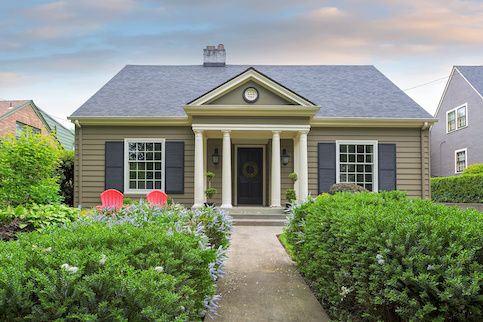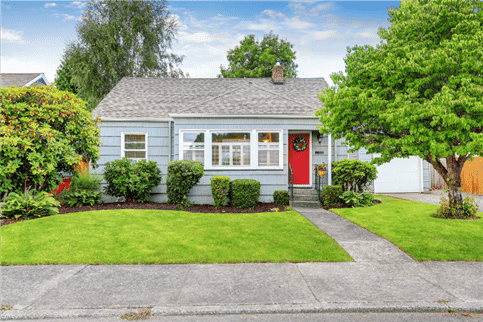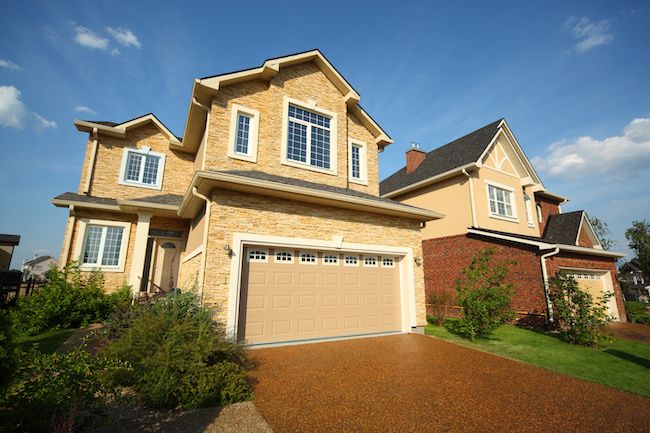If you’re looking to get a home loan, the two major structures are an adjustable-rate mortgage (ARM) and a fixed-rate mortgage. Knowing the difference between ARMs vs. fixed loans, with particular attention to similarities and potential payments, will help you choose the right mortgage for you.
What’s A Fixed-Rate Mortgage?
A fixed-rate mortgage is exactly as it sounds – the interest rate on your home loan is unchanged for the length of your term. Although commonly offered in 15-year or 30-year increments, lenders have the ability to offer custom terms of fewer than 10 years.
Like the interest rate, your monthly principal and interest payment won’t change. However, your overall mortgage payment could change due to the fluctuations in your homeowner’s insurance premiums and real estate taxes.
This loan appeals to many people because it gives them a sense of financial comfort. Even though your mortgage payment can vary a bit, the amount paid for the loan itself doesn’t change.
What’s Your Goal?
Buy A Home
Discover mortgage options that fit your unique financial needs.

Refinance
Refinance your mortgage to have more money for what matters.
Tap Into Equity
Use your home’s equity and unlock cash to achieve your goals.
What’s An Adjustable-Rate Mortgage (ARM)?
An adjustable-rate mortgage (ARM) features an interest rate that changes over time. While these may also be referred to as variable-rate mortgages, variable rates are traditionally associated with home equity lines of credit (HELOCs) and other financial instruments that have rates that can change every month or sooner. Hybrid ARMs are the ones commonly offered for traditional mortgages. For the rest of this article, we’ll speak of hybrid ARMs.
A hybrid ARM has an initial time frame at the beginning of the loan, during which the rate remains fixed. The fixed rate can last as long as 10 years or as little as 1 year. Once the fixed period expires, the interest rate adjusts at regular intervals based on an index, subject to caps, floors and margins. Once adjustment starts, it usually happens every 6 months or each year.
When evaluating hybrid ARMs, you’ll see them advertised as being a 10/1 ARM or 5/1 ARM, for example. The first number references how long the rate remains fixed. The second number references the adjustment interval. If you have a 5/6 ARM, the rate is fixed for 5 years and adjusts every 6 months thereafter. It may vary, but the loan term is usually 30 years.
Ready To Become A Homeowner?
Get matched with a lender that can help you find the right mortgage.
What Are The Differences Between Fixed- Vs. Adjustable-Rate Mortgages?
While certain differences in fixed mortgages and ARMs are more readily apparent than others, some of the finer details deserve attention.
Interest Rates
Interest rates for fixed-rate mortgages don’t change. Meanwhile, ARM rates do change, typically following fixed periods at the beginning of the loan. The ability to adjust or lack thereof leads to differences in the initial interest rate.
Because adjustable rates can change in response to movements in the financial markets, the initial rate is usually lower than fixed-rate loans to compensate the borrower for the risk being taken on. In contrast, fixed rates are higher because investors are trying to project the course of inflation over the term of the loan.
Indexes And Margins
When ARMs adjust, their rates change based on one of a number of indexes. The most commonly used indexes are any one of various maturity points for the Secured Overnight Financing Rate (SOFR) or the 1-year Constant Maturity Treasury (CMT). In some instances, the prime rate from the Wall Street Journal may be used.
The index figure on the scheduled date of adjustment is added to a margin specified in your loan contract to come up with your new interest rate until the next scheduled adjustment.
Caps And Floors
Caps and floors will come into play at each interest rate change. The cap or floor indicates how much a lender can increase or decrease the interest rate on each adjustment over the life of the loan. Typically, there are three separate caps and floors that apply depending on the time frame and how your adjustments have affected your loan in the past.
When you see ARM terms, they’ll be laid out in the following format: 5/1 ARM 2/1/5. While we covered the first two numbers earlier, the last three are new.
The 2 means that your rate can’t go up or down more than 2% on the initial adjustment. The middle number represents subsequent adjustments not moving rates more than 1%. Finally, over the life of the loan, your rate can’t go higher or lower by more than 5%. It’s worth noting that the lifetime floor may not come into play if it’s below the margin in your contract.
Term Length
Fixed-rate mortgages offer a greater variety of loan term lengths. As mentioned earlier, you can get a payoff time frame that’s fewer than 10 years all the way up to 30 years. Generally, the ARMs advertised for single-family residential housing (up to four units) are 30-year terms.
Take The First Step To Buying A Home
Find a lender that will work with your unique financial situation.
What Are The Similarities Between ARMs Vs. Fixed-Rate Mortgages?
Although there are significant differences when comparing an ARM vs. fixed mortgage, there are some attributes they have in common.
Borrower Requirements
The eligibility requirements for fixed and ARM loans are generally the same. However, there may be limited exceptions to this, including for jumbo loans and fixed-rate loans that help first-time home buyers or those meeting certain income thresholds.
The minimum down payment or equity amount for a non-first-time home buyer is still 3.5% for an FHA loan and 5% for a conventional loan to get a permanent residence regardless of the type of interest rate you have. There are also similar requirements in terms of credit score and debt-to-income ratio.
Potential To Refinance
Both fixed-rate mortgages and ARMs can be refinanced. Regardless of the structure of the loan, you can refinance to lower your rate or change your term, remove mortgage insurance or take cash out.
It should be noted that it’s also very common to refinance an ARM for the express purpose of locking in the long-term payment security associated with a fixed-rate mortgage.
Fixed-Rate Vs. ARM Monthly Payment Comparison
To make this real for you, we’ll do an example of what a monthly payment would like for an ARM and fixed-rate mortgage with the same loan amount.
The example uses a 5/1 ARM with 1/1/5 caps and floors. That means the ARM has an initial fixed interest rate for 5 years, then changes every year after. The interest rate cannot increase or decrease more than 1% on the initial adjustment, nor more than 1% with each adjustment after. And, for the life of the loan, the interest rate cannot go higher or lower by more than 5%.
Please note that the ARM example is a bit simplified because it represents the extremes – showing the highest and lowest interest rates it could adjust to. In reality, your loan probably wouldn’t go up or down by the maximum possible amount it could each year.
Fixed-Rate Vs. ARM Monthly Payment Comparison
| 30-year fixed-rate mortgage | 30-year 5/1 ARM | |
|---|---|---|
| Mortgage amount | $300,000 | $300,000 |
| Initial interest rate | 6.5% | 6.5% |
| Initial monthly payment | $1,896.20 | $1,896.20 |
| Interest rate (after the ARM’s 5-year fixed period) | 6.5% | High: 7.5% Low: 5.5% |
| Monthly payment (after the ARM’s 5-year fixed period) | $1,896.20 | High: $2,075.33 Low: $1,724.56 |
| Interest rate (after the annual adjustment) | 6.5% | High: 8.5% Low: 4.5% |
| Monthly payment (after the annual adjustment) | $1,896.20 | High: $2,256.61 Low: $1,565.72 |
| Interest rate (after the annual adjustment) | 6.5% | High: 9.5% Low: 3.5% |
| Monthly payment (after the annual adjustment) | $1,896.20 | High: $2,439.33 Low: $1,419.94 |
| Interest rate (after the annual adjustment) | 6.5% | High: 10.5% Low: 3.04% |
| Monthly payment (after the annual adjustment) | $1,896.20 | High: $2,622.84 Low: $1,357.92 |
| Interest rate (after the last possible ARM adjustment) | 6.5% | High: 11.5% Low: 3.04% |
| Monthly payment (after the last possible ARM adjustment) | $1,896.20 | High: $2,806.60 Low: $1,357.92 |
| Average interest rate | 6.5% | High: 10.323% Low: 3.77% |
| Interest paid | $382,633.47 | High: $633,763.62 Low: $228,704.93 |
Is A Fixed-Rate Mortgage Or ARM Better For You?
Identifying the differences and similarities is one of the first steps to deciding whether a fixed-rate mortgage or ARM makes the most sense for your situation. Knowing when to get one or the other is one step further.
When To Choose A Fixed-Rate Mortgage
Here’s when it could make sense to go with a fixed-rate mortgage:
- Long-term commitment: If you’re planning on living in your home for the long haul, you may wish to take advantage of the budget certainty that a fixed rate affords.
- Low mortgage rates: Are you currently benefiting from a low-rate environment? Locking in a long-term, fixed-rate option could help you avoid rising costs if the interest rates change.
- Less risk: It’s worth reiterating that having an interest rate that doesn’t change exposes you to less risk of financial strain if interest rates were to go up significantly and suddenly.
When To Choose An Adjustable-Rate Mortgage
Here are a few situations when an ARM might work out well for you:
- Short-term commitment: Whether you plan on moving a growing family into a bigger house or downsizing in a few years, if you don’t think you’ll be in your home long-term, you may find an ARM is right for you. You could take advantage of the lower initial rate while moving out before any adjustment takes place.
- Higher mortgage rates: If mortgage rates are currently high, you might choose to take an adjustable rate now with an eye toward refinancing if rates drop in the future.
- Flexibility: You might choose to take an ARM if you know you have several expenses (like furnishing a house) over the next couple of years as the lower initial rate could provide room in your budget. Another option is using the time with the lower rate to pay down more of your balance could mean saving money on interest and having a lower payment even when the rate adjusts.
- Higher mortgage amounts: The higher your loan amount, the more you’ll notice the differences on your monthly interest payment. Taking an ARM could mean lower monthly costs and less interest paid, particularly if you pay down the principal before the adjustment.
ARM Vs. Fixed-Rate Mortgage FAQs
With all the particulars covered, there’s likely a few lingering questions about fixed and adjustable rates. Here are the answers to some of the most common.
The Bottom Line
One of the primary decisions you have to make when getting a mortgage is whether to choose a fixed- or adjustable-rate mortgage. An ARM provides a lower rate in the short term while having the risk of increasing later on. In contrast, fixed rates tend to be slightly higher, but your mortgage payment is more stable.

Kevin Graham
Kevin Graham is a Senior Writer for Rocket Companies. He specializes in economics, mortgage qualification and personal finance topics. As someone with cerebral palsy spastic quadriplegia that requires the use of a wheelchair, he also takes on articles around modifying your home for physical challenges and smart home tech. Kevin has a bachelor's degree in journalism from Oakland University.












